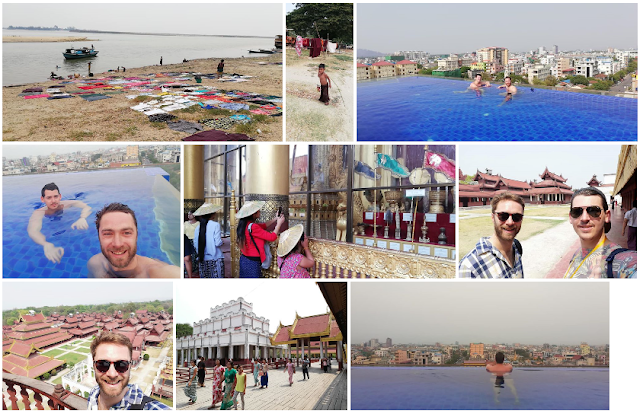Part 1- Yangon
There are quite a few sights worth visiting in the
(unofficial) capital city Yangon, we must say, despite the fact that we had
been told to skip it altogether: two days here is a long enough time to visit… This
is the amount of time I’d recommend.The garden city of Yangon maintains its charm with wide, tree-lined avenues, tranquil lakes and majestic colonial architecture.
We stopped at Insein to visit the pagoda there and the elephant park. Once we were back in Yangon city centre, we visited the Sule pagoda, and then headed to the highlight of this city: the jaw-dropping Shwedagon Pagoda, best seen at dusk, as you can watch the sunset over Yangon and enjoy the gentle sound of the pagoda bells chiming in the evening breeze. We ended our very productive with a tasty dinner at the Monsoon restaurant.
The Shwedagon Pagoda is a 98-metre-high stupa whose golden glow can be seen from throughout the city. The greenery of Yangon provides an enchanting backdrop to the beautiful shrine.
Next day, we took a walking tour of the downtown area’s majestic colonial architecture (we recommend lunch at Rangoon restaurant), we did some shopping at the Bogyoke Aung San Market, which is packed with hundreds of vendors selling a large selection of Myanmar handicrafts. In the afternoon we ferry ride to Dalah and tour there by motorbike, with a local guide (you’ll find plenty of those waiting for you by the river bank).
A good restaurant to try is House of Memories. Yangon is full of restaurants where you can sample traditional Myanmar food and delicacies influenced from other Asian countries including China, Thailand, India and Japan.
Part 2- Bagan
We reached Bagan by bus, and we couldn't hide our disappointment when we found out that we could not see the famous hot air balloons on the valley (they literally stopped doing it one day before we arrived, due to the official end of the dry season).
Everything else was just breath taking, including the hotel we stayed in: the Areindmar, which we strongly recommend! The temples area of Bagan contains over 2200 small and big temples (pagodas).
You can explore the African-looking area by bike or e-bike! Since July 2019, Bagan got its UNESCO World Heritage status which means that all temples are closed climbing up to the top to watch the sunrise.
My personal tips? Chill, explore, get lost in the valley,
take time to visit the temples (not just the big, well-known ones), and use a map to help you navigate the area. This
place is one of the most spiritual places I have ever been to...
Part 3- Inle Lake
A visit to Inle Lake in Myanmar is going to take
you back in time. Huge villages on the lake made of wood and/or bamboo. The
locals live their daily lives by working in their floating gardens, fishing,
creating handicraft and showing tourists how they live and what they do.
The number one thing to
do at Inle Lake is a boat tour.
Get out in the early morning, it is the very
best to experience the sunrise on the lake if you can. Your boat driver will
know where to go but he will give you some options that you can visit, or not.
Visit the fishermen during sunrise or sunset. It
is impressive to see how they easily balance on the tip of the boat trying to
get fish into their netted cages.
The floating garden is one unique piece of work.
The pieces of ground are being held together with bamboo, floating on the lake.
The area is huge and produces many kinds of vegetables year-round.
The long-necked women are tribes that seem to fade
out more and more over the next years, which makes it even more special to
visit them. The ladies are working on their garment.
This is pure for tourism
purposes to show-off their ‘giraffe necks’. Worth a visit!
There are many small workshops, factories, and
shops on the lake, some more interesting than the other. You can visit shops
like cigar or gold maker and factories where they create beautiful clothing.
Rent a
bike and explore the area around Inle Lake and wander around in the town near
Inle Lake called Nyaung-Shwe. I would say at least three full days by the lake are necessary to fully enjoy this special place.
Part 4- Mandalay
Mandalay, the economic and religious hub of
Myanmar, is full of attractions to visit, the first of which is the Royal
Palace. This is where you can learn a great deal about the architecture and
etiquette of the last royals of Myanmar.
A hill covered in spires and pagodas at the
northeast of Mandalay Palace, which offers 360-degree viewpoint of the town and
beyond, is no other than the Mandalay Hill. You will get to watch the most epic
sunset from the hill and the breathtaking view of Mandalay city.
Mandalay and surrounding towns are known for
hundreds of pagodas and monasteries found in the area. Many famous Pagodas such
as Mandalay Myat Muni Pagoda and Kuthodaw Pagoda, which is the site of the
world’s largest book are located in Mandalay.
We rented a scooter and went to one of the three Royal Cities and the U-bein Bridge, a 1.2-kilometre bridge which was built around 1850 and
is believed to be the oldest and longest teakwood bridge in the world. Only
problem is that we struggled with the heat that day, due to the extremely high temperatures.

























No comments:
Post a Comment